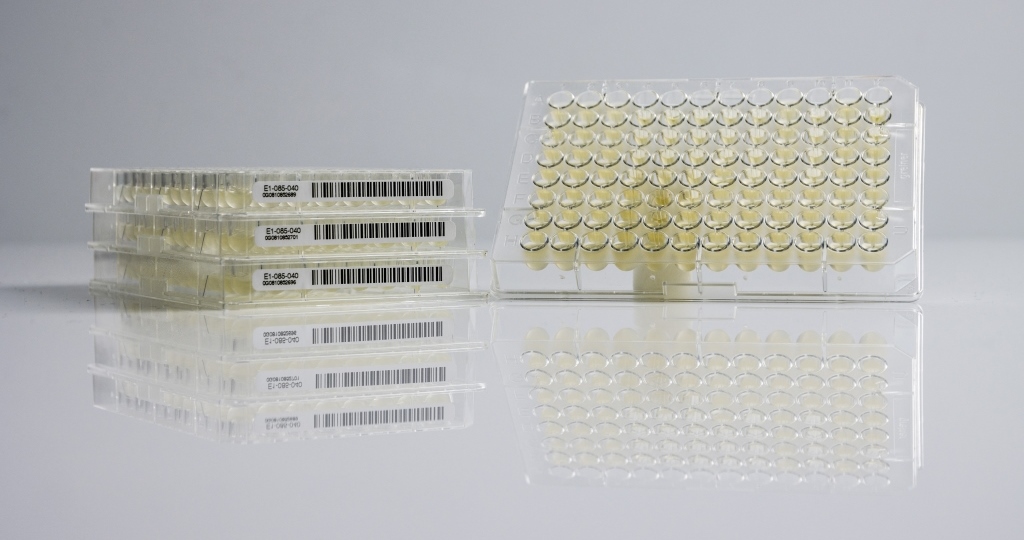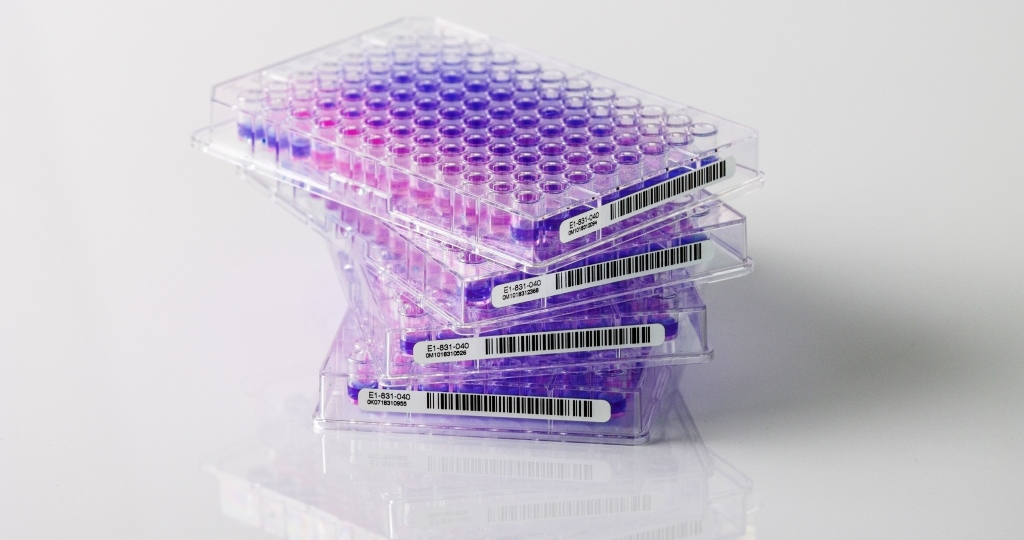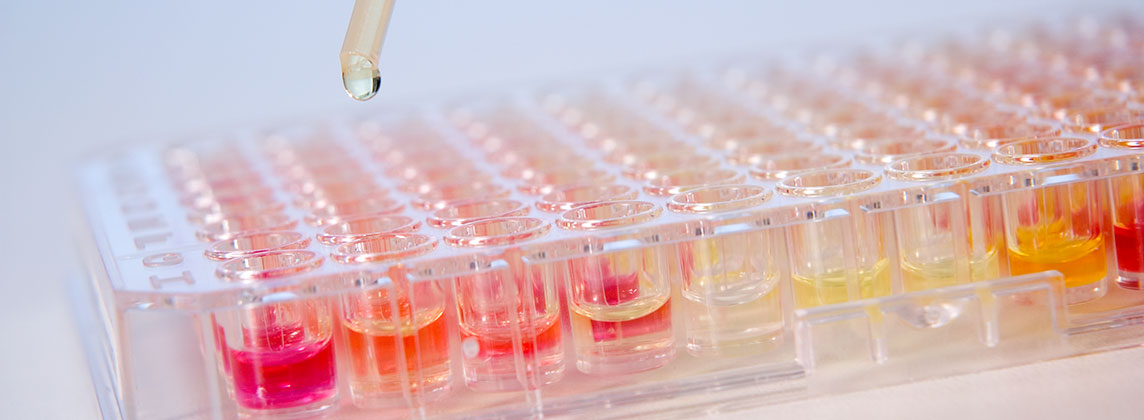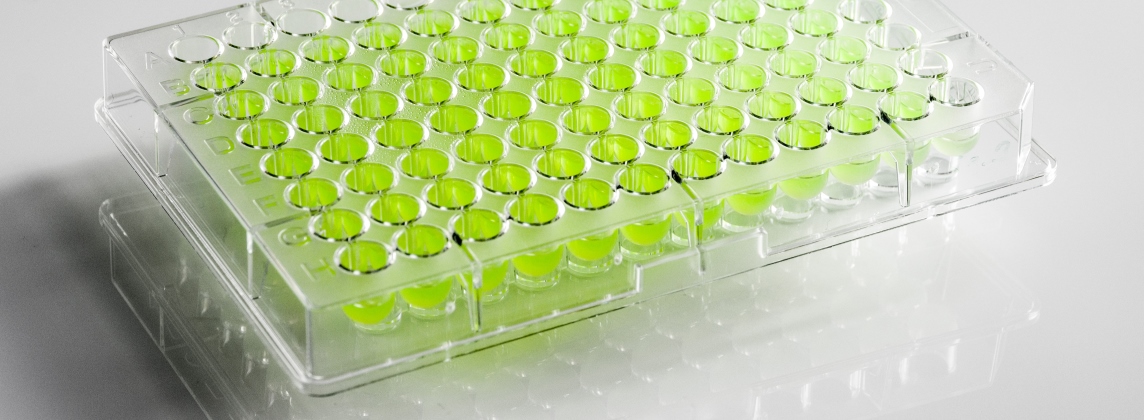MICRONAUT Special Plates
Antimicrobial susceptibility testing with standard MIC plates covering an extended spectrum of organisms in microbiology
Test Principle
The antimicrobial susceptibility testing of the MICRONAUT-S/-AM plates is based on the rehydration of antibacterial agents and/or antifungal agents by the addition of a standardized suspension of bacteria or yeasts. The plates can be read after an incubation of 24-48 hours at a temperature of 30°C or 35-37°C (depending on test system and organism) with a reader or visually. Data recorded by automated reading can be evaluated and interpreted by MICRONAUT software.
PRODUCTS
MICRONAUT-S MRSA GP
Microtitration plates for the automated or manual susceptibility testing of multi-resistent Staphylococci, Enterococci and Pneumococci
Principle, shelf-life and storage
The susceptibility testing is based on the rehydration of antibiotics by adding a standardized bacteria suspension (Mueller-Hinton II broth). The result is measured photometrically after 18-24 hours incubation at 35-37°C. Results are going to be measured and interpreted either with the MICRONAUT software or visually. Due to a special vacuum drying method the plates can be stored at a room temperature of 15-25°C. The MICRONAUT test plates have a shelf life of 24 months at date of production.
Antibiotics configuration
The antibiotics configuration of the MICRONAUT-S MRSA GP plate allows the specific detection of the clinically relevant single or multi-resistances of gram-positive bacteria of nosocomial infection. The susceptibility testing with highly effictive reserve antibiotics like the MRSA cephalosprine Ceftaroline offers alternatives in case of extreme multi-resistance.
Procedure
- Produce bacteria suspension in NaCl (McFarland 0.5)
- Transfer in Mueller-Hinton II broth
- Inoculate MICRONAUT-S test plate
- Incubate for 18-24 hours at 35-37°C
- Measure photometrically and interprete with MICRONAUT software
Susceptibility testing of staphylococci
- Penicillin G MIC: detection of staphylococcal penicillinases
- Detection of Oxacillin resistance by MIC determination with Oxacillin and Cefoxitin
- Detection of Oxacillin borderline resistance by detection of Cefoxitin susceptibility
- Detection of the induced MLSB resistence by Erythromycin/Clindamycin combination test according to CLSI standard
- Testing of highly effective antibiotics like Vancomycin, Linezolid, Tigecycline, Daptomycin, and Ceftaroline as therapeutic options in case of extreme multi-resistance
- Test interpretation according to EUCAST and CLSI standard
Susceptibility testing of enterococci
- Ampicillin MIC: detection of ampicillin resistance
- Detection of the phenotypical glycopeptide resistance pattern of Vancomycin resistant enterococci by determination of the MIC via Teicoplanin and Vancomycin
- Differentiation between Enterococcus faecium and Enterococcus faecalis by determination of the MIC via Synercid®
- Detection of HLAR strains through high-level-resistance testing via Gentamicin and Streptomycin
- Testing of highly effective antibiotics as therapeutic options in case of extreme multi-resistance
- Test interpretation according to EUCAST and CLSI standard
Susceptibility testing of pneumococci
- Penicillin G MIC: detection of PBP changes
- Detection of Cefotaxim resistance
- Detection of Erythromycin resistance
- Detection of Vancomycin resistance
- Moxifloxacin MIC: detection of group IV quinolones resistance
- Test of highly effective antibiotics as therapeutic options in case of extreme multi-resistance
- Test interpretation according to EUCAST and CLSI standard
All information can be found in the product description MICRONAUT-S MRSA GP. The detailed layout is available on request.
MICRONAUT-S ß-Lactamases (MBL, ESBL, KPC, AMP-C, OXA-48)
Phenotypical detection of multiple ß-Lactamases (multiple resistance determinants) in a single test system
Based on the micro-dilution procedure MICRONAUT‑S provides the phenotypical detection of clinically relevant cephalosporinases and carbapenemases at entero-bacteria and non-fermenters.
NEW: Extended spectrum of antibiotics by Temocillin and Ertapenem-/Meropenem screening concentrations for detection of OXA-48 like Type D-carbapenemases
In recent years there was an increase worldwide in carbapenem resistance based on type D carbapenemase producing Enterobacteriaceae (type OXA-48). These secondary, plasmid encoded type D carbapenemases can be spread horizontally by plasmid transfer and therefore showing a potential of dissemination of high epidemiologic importance. Moreover the ß-lactamases resistance determinants are localized on mobile genetic elements (integrons) which are normally associated with additional resistance genes (e. g., aminoglycosides, fluoroquinolones etc.) bearing the high risk for the spread of multi-resistance among clinical relevant pathogens.
The novel standard plate MICRONAUT-S ß-Lactamases now includes temocillin and ertapenem-/meropenem screening concentrations for detection of low-level carbapenem resistance. These modifications improve the sensitivity of the test system for detection of OXA-48-like type D carbapenemases.
Extended concentration range for ESBL and AMP-C detection
In the new MICRONAUT-S ß-Lactamases plate the drug concentrations of cefepime, cefotaxime, and ceftazidime are increased up to 128 µg/ml. Based on the new drug concentration ranges the sensitivity of the ESBL- and AMP-C confirmatory assay is raised by the reduction of “out of range” results.
An overview about the scope of the enhanced plate MICRONAUT-S ß-Lactamases
- Resistance determination of all relevant gram-negative bacteria (enterobacteria, Aeromonas, non-fermenters) against 6 antibiotics and 7 antibiotics combinations in a standard micro-dilution procedure
- Phenotypical detection of MBL (metallo-ß-lactamases) by resistance determination against Meropenem as a mono substance and in combination with the divalent cationic chelator EDTA
- Phenotypical detection of ESBL (extended spectrum ß-lactamases) by the susceptibility testing with 3 extended spectrum cephalosporins and their combination with Clavulan acid
- Phenotypical detection of KPC (Klebsiella pneumoniae carbapenemase) by resistance determination against Meropenem as a mono substance and in combination with 3- Amino-Phenyl-Borat (3- APB)
- Phenotypical detection of AMP-C (Aminopenicillin inactivating cephalosporins) by the susceptibility testing with 3 extended spectrum cephalosporins and their combination with 3- Amino-Phenyl-Borat (3- APB)
- Detection of OXA-48-like type D carbapenemases based on the determination of temocillin high-level resistance
- Detection of low-level carbapenem resistance by introduction of ertapenem-/meropenem screening concentrations
- Analysis and interpretation after visual or automated reading
- MICRONAUT software for the analysis and interpretation after automated reading with:
- Indication of confirmed resistance mechanisms (ESBL | MBL | KPC | AMP-C | OXA-48-like) by MIC quotient assessment and determination of temocillin high-level resistance
- Phenotypcal confirmation of resistance mechanisms even at the occurrence of multiple ß-lactamases
All information can be found in the product description MICRONAUT-S ß-Lactamases. The detailed layout is available on request.
NEW | MICRONAUT-S Carbapenemases Detection
Two-test-plate for phenotypic detection of type A carbapenemases (e.g. KPC), metallo-β-lactamases, and OXA-48-like type D carbapenemases in enterobacteria and Pseudomonas aeruginosa.
The new two-test-plate MICRONAUT-S Carbapenemases Detection, which is based on broth microdilution procedure, provides phenotypic detection of clinically relevant carbapenemases (type A carbapenemases (e.g. KPC), metallo-β-lactamases, and OXA-48-like type D carbapenemases) in enterobacteria and Pseudomonas aeruginosa.
NEW: Phenotypic confirmatory assay of OXA-48-like type D carbapenemases in enterobacteria by the new inhibitor combination meropenem / avibactam and determination of high-level temocillin resistance.
In recent years, there was a steady increase of carbapenem resistance worldwide due to the spread of type D carbapenemase producing Enterobacteriaceae (type OXA-48-like). These secondary, plasmid encoded type D carbapenemases can be spread horizontally by plasmid transfer and are therefore of high epidemiologic importance. Moreover, the ß-lactamases resistance determinants are localized on mobile genetic elements (integrons), which may be associated with genes conferring resistance to other antibiotic classes (aminoglycosides, fluoroquinolones etc.). The latter is of high risk for the spread of multi-resistance among clinical relevant pathogens.
The new two-test plate MICRONAUT-S Carbapenemases Detection contains first the inhibitor combination meropenem / avibactam. The new beta-lactamase inhibitor avibactam shows inhibitory activity against type D carbapenemases. If temocillin high-level resistance is detected as well, an OXA-48-like type D carbapenemase can be phenotypically confirmed.
By selection of the concentration ranges of meropenem as mono compound (0.06 - 128 μg/ml) and the inhibitor combinations meropenem/3-amino-phenyl-borate (3- APB), meropenem/EDTA and meropenem/avibactam (each 0.031 - 32 μg/ml), the detection of type A carbapenemases (e.g. KPC), metallo-β-lactamases and OXA-48-like type D carbapenemases is possible when the meropenem screening cut-off concentration for enterobacteria is exceeded[1].
[1] EUCAST guidelines for detection of resistance mechanisms and specific resistances of clinical and/or epidemiological importance. EUCAST Version 2.0, July 2017
An overview about the scope of the new two-test-plate MICRONAUT-S Carbapenemases Detection
- New phenotypic confirmatory assay for the detection of OXA-48-like type D carbapenemases in enterobacteria by MIC determination of meropenem as mono-compound and in combination with the new ß-lactamase inhibitor avibactam and the determination of temocillin high-level resistance
- Phenotypic detection of MBL (metallo-ß-lactamases) by MIC determination of Meropenem as mono-compound and in combination with the divalent cationic chelator EDTA
- Phenotypic detection of type A carbapenemases (e.g. KPC) by MIC determination of Meropenem as mono-compound and in combination with 3-Amino-Phenyl-Borate (3- APB)
- Phenotypic confirmation of carbapenemases (type A carbapenemases (e.g., KPC), metallo-β-lactamases, OXA-48-like type D carbapenemases) possible when the meropenem screening cut-off concentration is exceeded (> 0.125 μg / ml).
- Two isolates can be tested per plate.
- Analysis and interpretation by visual or photometric reading
- The MICRONAUT software for the analysis and interpretation after photometric reading provides indication of confirmed resistance mechanisms (MBL / KPC / OXA-48) by calculation of a MIC quotient and detection of (high-level) temocillin resistance.
All information can be found in the product description MICRONAUT-S Carbapenemases Detection. The detailed layout is available on request.
MICRONAUT-S MDR MRGN-Screening
MIC plate for the susceptibility testing of multi-resistent gram-negative bacteria
Based on the micro-dilution procedure MICRONAUT-S MDR MRGN Screening provides the phenotypical detection of clinically relevant cephalosporinases and carbapenemases at entero-bacteria and non-fermenters.
NEW ⇒ Extended spectrum of antibiotics by meropenem screening concentrations for an improved detection of OXA-48-like type D carbapenemases
NEW ⇒ Extended spectrum of antibiotics by introduction of the novel antibiotic combinations ceftazidime-avibactam and ceftolozane-tazobactam
- Resistance determination of all relevant gram-negative bacteria (enterobacteria, Aeromonas, non-fermenters) against antibiotics and antibiotics combinations in a standard micro-dilution procedure
- Antimicrobial susceptibility testing against the novel antibiotic combinations ceftazidime-avibactam and ceftolozane-tazobactam
- Phenotypical detection of MBL (metallo-ß-lactamases) by resistance determination against Meropenem as a mono substance and in combination with the divalent cationic chelator EDTA
- Phenotypical detection of KPC (Klebsiella pneumoniae carbapenemase) by resistance determination against Meropenem as a mono substance and in combination with 3- Amino-Phenyl-Borat (3- APB)
- Phenotypical detection of AMP-C (Aminopenicillin inactivating cephalosporins) by the susceptibility testing with 3 extended spectrum cephalosporins and their combination with 3- Amino-Phenyl-Borat (3- APB)
- Detection of OXA-48-like type D carbapenemases based on the determination of temocillin high-level resistance
- Detection of low-level carbapenem resistance by introduction of meropenem screening concentrations
- Analysis and interpretation after visual or automated reading according to EUCAST or CLSI standard
- MICRONAUT software for the analysis and interpretation after automated reading with:
- Indication of confirmed resistance mechanisms (MBL | KPC | AMP-C | OXA-48-like) by MIC quotient assessment and determination of temocillin high-level resistance
- Phenotypcal confirmation of resistance mechanisms even at the occurrence of multiple ß-lactamases
All information can be found in the product description MICRONAUT-S MDR MRGN-Screening. The detailed layout is available on request.
MICRONAUT-S Pneumococcus and Haemophilus
- For detection of resistence by MIC determination towards relevant antimicrobial agents
MICRONAUT-S Anaerobes MIC

For MIC determination towards antimicrobial agents with high avctivity against anaerobes inclusive compounds like tigecycline, moxifloxacin, or ertapenem.
Further information provides the product description about MICRONAUT-S Anaerobes MIC
MICRONAUT-AM
MIC plates for the automated or manual susceptibility testing of yeast

The susceptibility testing is based on the rehydration of antimycotics by adding a standardized yeast suspension. After incubation of 24-48 hours at 35-37ºC the plates are ready to be measured photometrically or be interpreted visually. Because of a special vacuum drying process the plates can be stored at a room temperature of 15-25°C. MICRONAUT test plates have a shelf life of 24 months at date of production.
Features of the MICRONAUT-AM system
- Susceptibility testing of up to 9 antimycotics in up to 11 concentrations following the MIC procedure (minimum inhibitory concentration)
- Contains the antimycotics Anidulafungin, Caspofungin and Posaconazol
- The included negative control simplifies the visual as well as the photometrical reading
- RPMI medium improves the growth of the yeast
- Interpretation after 24 hours for yeast and 48 hours for cryptococci
- Interpretation according to EUCAST Guidelines
Procedure
- Preparation of yeast suspension in NaCl 0.9 % (McFarland 0.5)
- Transfer to RPMI medium plus AST indicator
- Inoculation of MICRONAUT-AM test plate
- Incubation at 35-37°C for 24-48 hours
- Incubation period depending on color change (pink) of the growth control
- Photometrical or visual reading of the test plates
Further details provides the product description about MICRONAUT-AM
Further MICRONAUT plates on demand. Don't hesitate to contact us. We develop the layout for your requirements.
MICRONAUT AST-SYSTEMS
Get here your deeper insight
Download
Product descriptions


